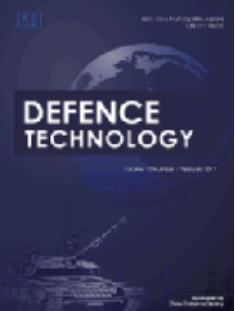A self-sensing HTPB liner for non-destructive monitoring nitroglycerin (NG) migration at the interface between double base propellant and the HTPB liner
IF 5.9
Q1 ENGINEERING, MULTIDISCIPLINARY
引用次数: 0
Abstract
During the storage of composite propellants, the migration of plasticizers and other unbonded additives at the interfaces of liner adhesives has garnered significant attention in understanding liner failure mechanisms, aging processes, and safety performance. However, there is currently no non-destructive and quantitative detection method for migration of plasticizers in propellant liner. In this study, we developed a HTPB sensing liner by incorporating conductive fillers—namely carbon black (CB), carbon nanotubes (CNTs), and graphene nanoplatelets (GNP)—into the HTPB matrix. The synergistic interaction between CNTs and GNP facilitates the formation of a tunneling conductive network that imparts electrical conductivity to the HTPB liner. To elucidate the functional relationship between conductivity and nitroglycerin (NG) migration, we applied the HTPB sensing liner onto double base propellant surfaces and measured both the conductivity of the sensing layer and NG migration during a 71 °C accelerated aging experiment. The results shows that when CNTs/GNP content reaches 3wt%, there is an exponential correlation between conductivity and NG migration with a fitting degree of 0.9652; the average response sensitivity of ΔR/R0 relative to NG migration is calculated as 41.69, with an average deviation of merely 5.67% between NG migrations derived from conductivity fittings compared to those obtained via TGA testing results. Overall, this sensing liner exhibits excellent capabilities for detecting NG migration non-destructively and quantitatively while offering a novel approach for assessing interfacial component migrations as well as debonding defects in propellants—a promising avenue for future self-monitoring strategies regarding propellant integrity.
一种用于无损监测双基推进剂与HTPB衬里界面硝酸甘油迁移的自传感HTPB衬里
在复合推进剂的储存过程中,增塑剂和其他未粘合添加剂在衬板粘合剂界面上的迁移引起了人们对衬板失效机制、老化过程和安全性能的重要关注。然而,目前对于推进剂内衬中增塑剂的迁移还没有无损定量的检测方法。在这项研究中,我们通过将导电填料——即炭黑(CB)、碳纳米管(CNTs)和石墨烯纳米片(GNP)——加入到HTPB基质中,开发了一种HTPB传感衬垫。CNTs和GNP之间的协同相互作用促进了隧道导电网络的形成,从而使HTPB衬垫具有导电性。为了阐明电导率与硝酸甘油(NG)迁移之间的功能关系,我们将HTPB传感衬垫应用于双基推进剂表面,并在71°C加速老化实验中测量了传感层的电导率和NG迁移。结果表明:当CNTs/GNP含量达到3wt%时,电导率与NG迁移呈指数相关,拟合度为0.9652;计算得出ΔR/R0相对于NG迁移的平均响应灵敏度为41.69,电导率接头得出的NG迁移与通过TGA测试结果得出的NG迁移之间的平均偏差仅为5.67%。总的来说,这种传感衬垫在非破坏性和定量检测NG迁移方面表现出出色的能力,同时为评估推进剂中的界面成分迁移和脱粘缺陷提供了一种新的方法,这是未来关于推进剂完整性的自我监测策略的一个有希望的途径。
本文章由计算机程序翻译,如有差异,请以英文原文为准。
求助全文
约1分钟内获得全文
求助全文
来源期刊

Defence Technology(防务技术)
Mechanical Engineering, Control and Systems Engineering, Industrial and Manufacturing Engineering
CiteScore
8.70
自引率
0.00%
发文量
728
审稿时长
25 days
期刊介绍:
Defence Technology, a peer reviewed journal, is published monthly and aims to become the best international academic exchange platform for the research related to defence technology. It publishes original research papers having direct bearing on defence, with a balanced coverage on analytical, experimental, numerical simulation and applied investigations. It covers various disciplines of science, technology and engineering.
 求助内容:
求助内容: 应助结果提醒方式:
应助结果提醒方式:


